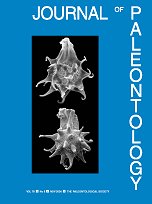Pectinids are the most abundant and widely distributed taxa in the Tertiary marine beds of Patagonia. Along with other very common molluscan species, they characterize five assemblages, from oldest to youngest: 1) the Oligocene Panopea sierrana– Parinomya patagonensis Assemblage; 2) the Late Oligocene–Early Miocene Jorgechlamys centralis–Reticulochlamys borjasensis Assemblage; 3) the Early Miocene Reticulochlamys zinsmeisteri–Struthiolarella patagoniensis–Pleuromeris cruzensis Assemblage; 4) the Early Miocene Pseudoportlandia glabra–Antimelatoma quemadensis Assemblage; and 5) the latest Early Miocene–earliest Middle Miocene Nodipecten sp.–Venericor abasolensis–Glycymerita camaronesia Assemblage. A brief analysis of the origin and composition of these Tertiary Patagonian molluscan faunas is provided. Striking compositional changes occurred through time, recorded mainly in the Late Paleocene, Late Eocene, Late Oligocene–Early Miocene, and Late Miocene.
How to translate text using browser tools
1 November 2004
TERTIARY MARINE MOLLUSCAN ASSEMBLAGES OF EASTERN PATAGONIA (ARGENTINA): A BIOSTRATIGRAPHIC ANALYSIS
CLAUDIA JULIA del RÍO
ACCESS THE FULL ARTICLE

Journal of Paleontology
Vol. 78 • No. 6
November 2004
Vol. 78 • No. 6
November 2004




